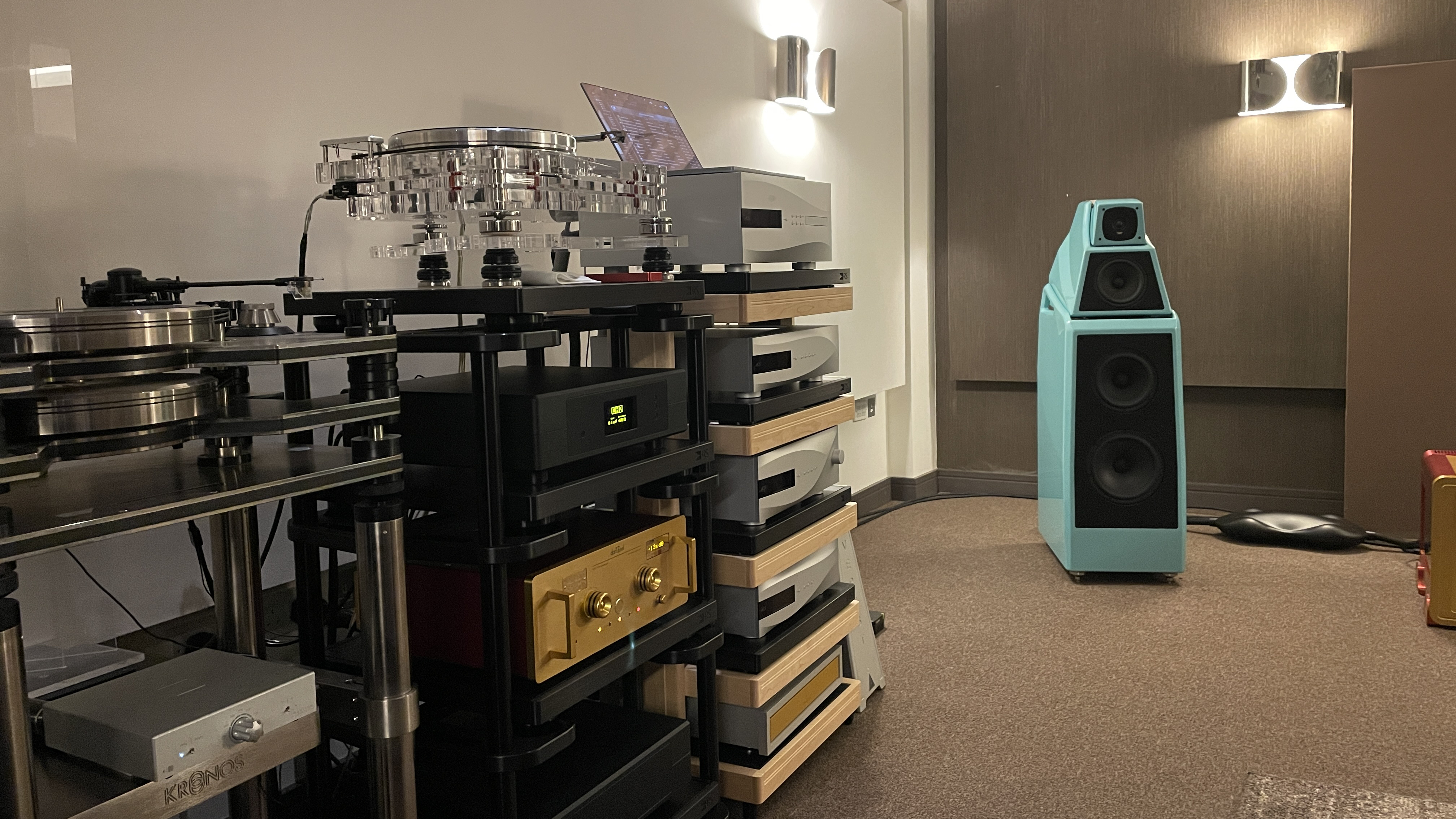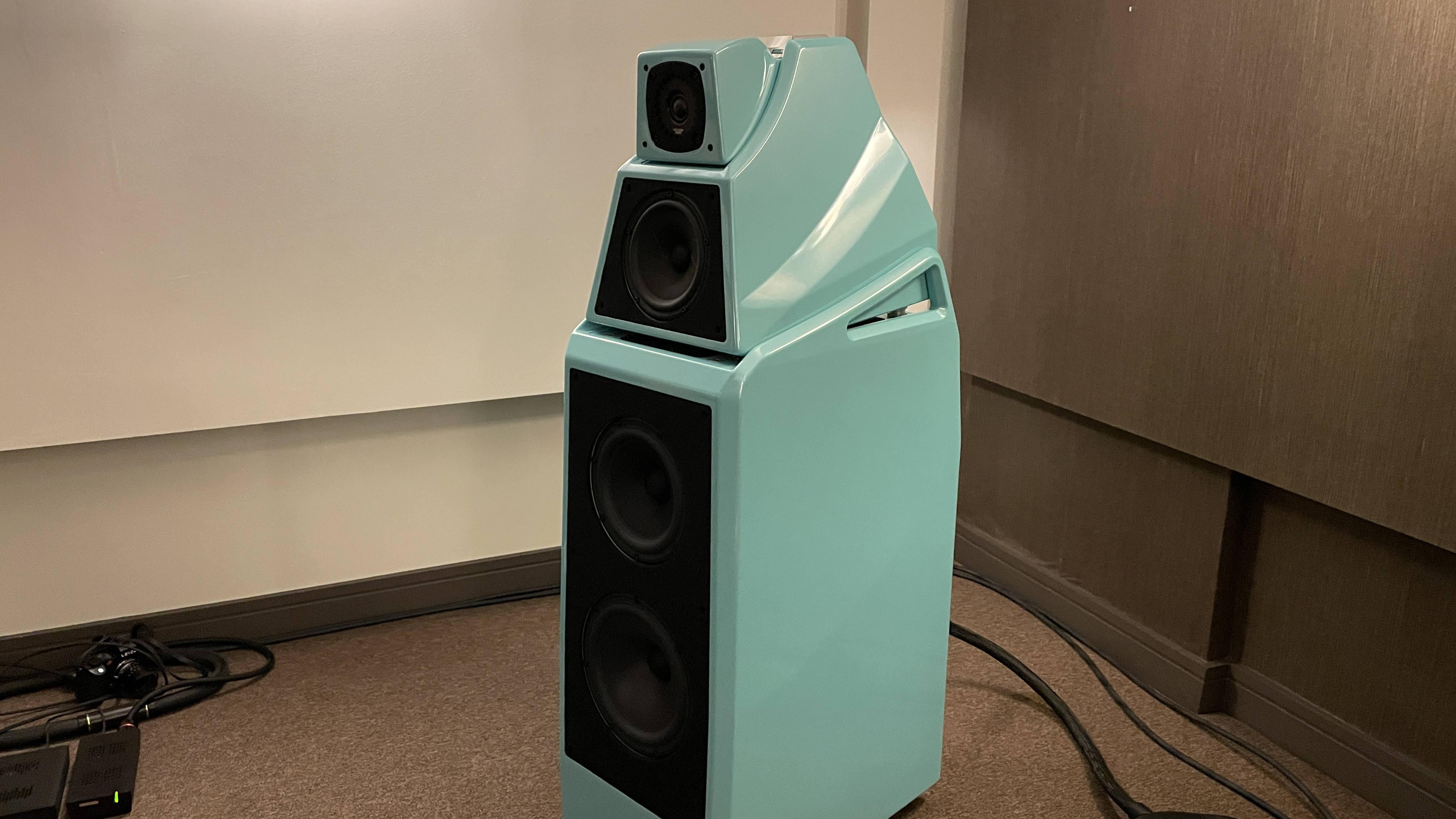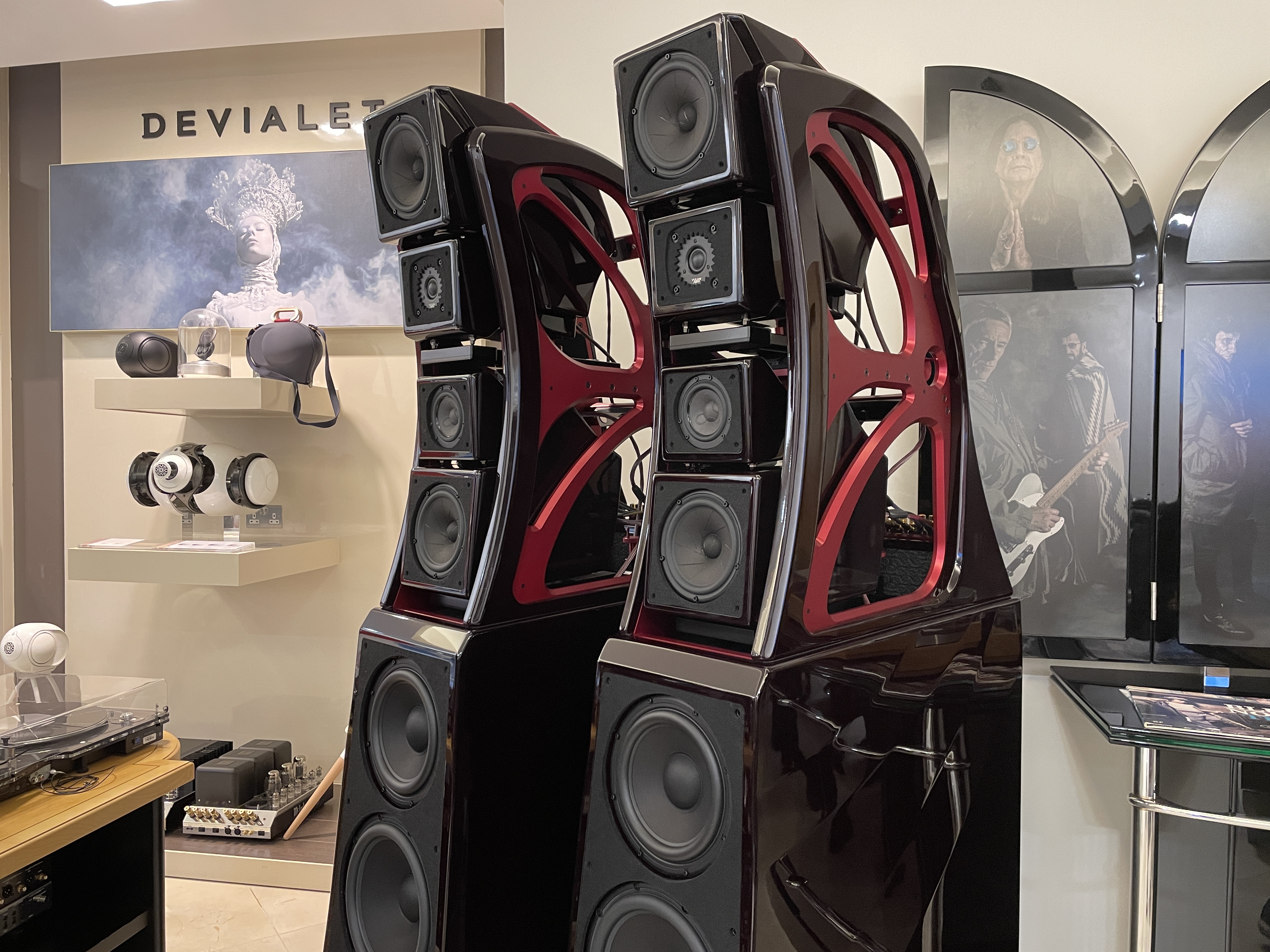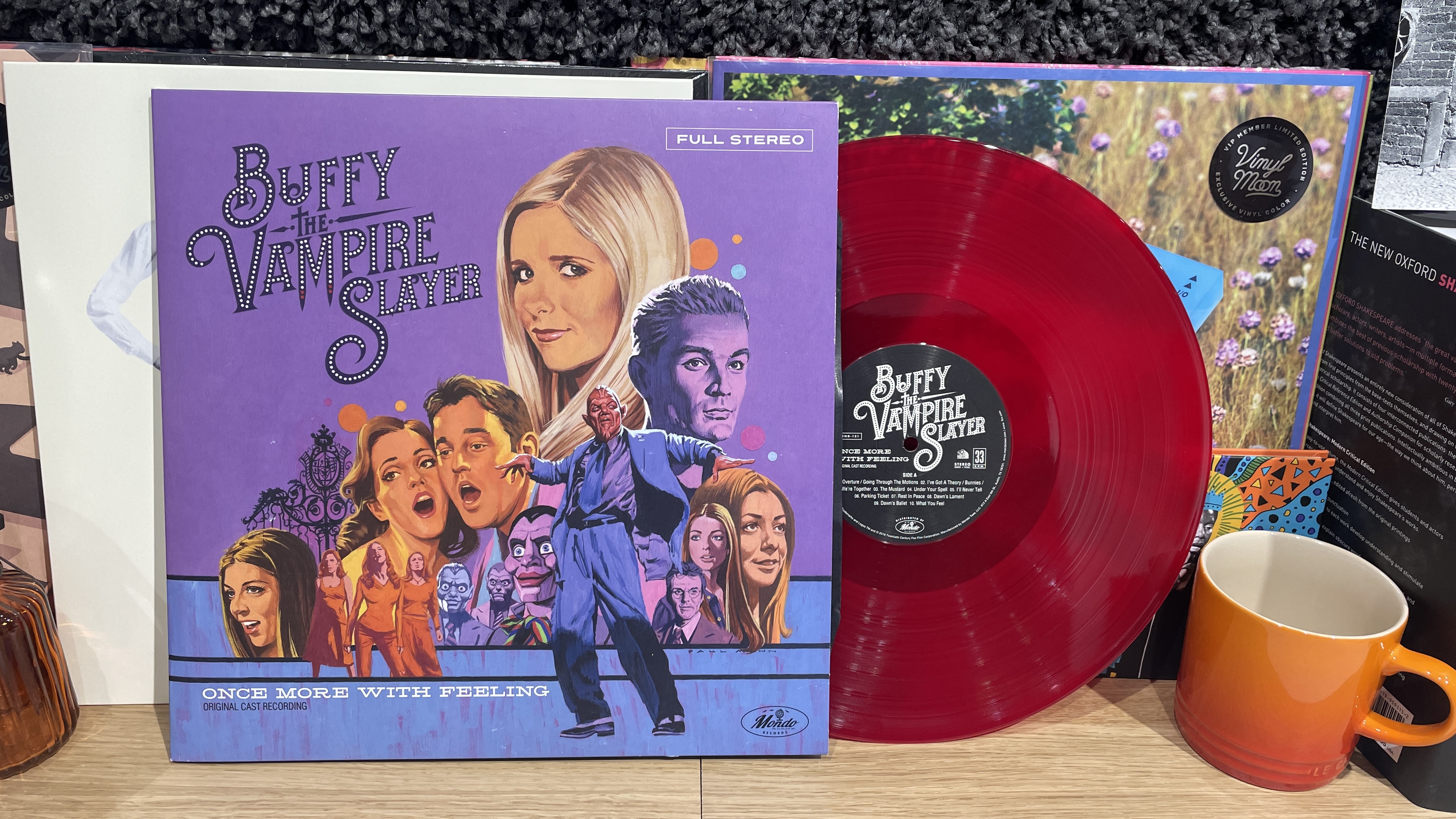I listened to Wilson Audio's new £80k stereo speakers - and they sounded like I was right in front of an orchestra
What do £80,000 speakers sound like?

We’re no strangers to high-end hi-fi here at What Hi-Fi?, but even I said “how much?!” when confronted with a pair of speakers costing £80,000.
American brand Wilson Audio’s loudspeakers are firmly in the ultra-high-end territory and have impressed us with five-star performers in the past, so I absolutely couldn’t turn down the chance to listen to the newly launched Wilson Audio Alexia V speakers in the flesh.
These are the first pair of Alexia V speakers in the UK, and the first thing that catches my eye is the rather fetching (and refreshing) “spearmint” blue finish. You can have Wilson Audio speakers made to order in any colour of your choice. Now that’s the kind of service I can expect for speakers that cost equivalent to a house deposit.
I know this is an astounding amount to pay for a pair of speakers. The Alexia V’s £80k price tag is very much out of the reach of most (technically £79,888 per pair, and between $67,500 and $79,500), but in Wilson Audio’s loudspeaker range – which includes the £350k Chronosonic XVX that’s around seven feet tall and looks more futuristic than the USS Enterprise – this new floorstanding speaker is practically “modest”.
The speakers’ “domesticated footprint” is another term used by Peter McGrath (Wilson Audio ambassador and also a renowned recording engineer) that needs to be defined in context. He stipulates that the dimensions of this floorstanding pair are better suited for smaller homes (which can’t accommodate the aforementioned massive Chronosonic XVX speakers, of course).
But it isn’t just the unusual, sci-fi design or sky-high price tag that makes the Alexia V speakers stand out. There’s a huge amount of serious hi-fi engineering happening inside that aims to deliver the best sound you can get in your (large) living room. The full details are in our Alexia V news story, but I wanted to highlight a couple of key innovations that stood out to me from the presentation.

Wilson Audio, based in Utah, USA, consists of a small team of just 52 people, and every single speaker and its components are hand made by this team (apart from drivers which are sourced mainly from Scandinavia). What’s highly unusual is that Wilson Audio makes its own capacitors for the crossover network, in the in-house capacitor manufacturing department called Reliable Capacitors. It’s an unusual feat for a speaker brand and ensures the industry-leading tight tolerances claimed by the company.
Get the What Hi-Fi? Newsletter
The latest hi-fi, home cinema and tech news, reviews, buying advice and deals, direct to your inbox.
The tolerance number that McGrath states is astonishing. Most high quality capacitors allow for a tolerance of 3 - 10 per cent; in Wilson Audio speakers such as the Alexia V, the tolerance is down to 0.1 per cent. That’s one-tenth of one per cent – something almost unheard of and guarantees more precision in the crossover design.
The Alexia V is a three-way design made up of four drivers – 1in silk fabric tweeter, 7in midrange, 8in and 10in paper pulp woofers – and plenty of technology innovations that were first developed for the top-range models like the Chronosonic XVX have made their way into this “mid-range” model. This includes the use of Wilson’s V-Material (a proprietary composite material), which has significantly better acoustic absorption properties, says McGrath, and is nested in strategic locations in the speaker’s enclosure to better isolate and reduce vibrations. Incidentally, the V in Alexia’s name refers to this V-Material, not the number five.
Wilson Audio are “champions of time alignment” – a bold claim that McGrath follows up with the fact that it's possible to adjust the relative positions of the drivers to reduce any timing differences between them down to around 11 microseconds. This should result in a very well-integrated sound across all four drivers, along with expectations of better precision, improved transient response and clarity from the high frequencies.

Despite all this intimidating technology and their grand presence, the Alexia Vs are supposedly relatively easy to run: they have a 90dB sensitivity, and can even be paired with a good 50W per channel stereo amplifier, McGrath says confidently. However, you will get the benefit of the huge dynamics and scale from these speakers if using an amp with more power.
In our demo in London’s KJ West One showroom, the Alexia Vs were partnered with suitably impressive sources and partnering equipment: darTZeel pre/power amplifiers and dCS digital components, with a Vertere RG-1 turntable for vinyl and Tidal with Audirvana software running on a MacBook for digital streams.
I was played a selection of music from high-quality vinyl pressings to 24-bit MQA Tidal streams. McGrath also has a parallel career as a classical music recording engineer (since the 1960s), and some of the played tracks were recorded specifically by him, in various music venues in his hometown of Miami, Florida.

So, what do these £80k Alexia V speakers actually sound like?
I have to dispatch our usual disclaimer here that I heard these speakers in an unfamiliar demo space so can’t account for the room and system’s effect on the speakers. I was also sitting in a not-ideal position off-centre of the middle sweet spot, sharing space with other media and noise distractions – far from an ideal listening environment – so I can only share what my general impressions were.
The scale of sound was immense, but even more impressive was the incredible amount of detail resolution and dynamics conveyed. I was struck by the absolute clarity of each note, and true to its time alignment claims, the speakers sounded very well integrated from even where I was sat. Everything was well placed and in focus, no matter how demanding or complex.
Holst’s The Planets kicked us off with big-scale dynamics and a wonderfully open presentation, in which individual instruments were given plenty of space to shine. Strings had layers upon layers of texture, I could hear every pass of the bow and was transported alongside the swell of music as the orchestra geared towards a crescendo.
There’s a great sense of solidity and weight to each track played, which further aids a driving sense of momentum. Much like the 120kg speakers (each), there’s plenty of heft to the Alexia V’s sound.
McGrath highlighted the Alexia V’s ability to deliver a stonking amount of low frequency considering its “modest” size (the internal woofer enclosure volume has increased since the last Alexia Series 2 iteration in 2017) and I heard – more like felt – deep, textured bass that was at times room-shaking.
Timing and rhythmic cohesion seem good, but my attention was taken more by the convincing way dynamic shifts are handled – there’s drama and emotion to the flow of music. Silences in between notes were clean, with impressively low distortion meaning I didn’t even wince when the volume was cranked up high. And the Alexia Vs can certainly go loud.
Flight of the Cosmic Hippo by Béla Fleck and the Flecktones had a sprightly sense of agility with a delightfully funky bassline that sounded fun through the Alexia V.
The demo in particular showed off how well live music can be relayed and experienced at home. A lovely piano piece by Macedonian pianist Simon Trpčeski (recorded in South Miami’s Wertheim concert hall) sounds stunningly clear and detailed. Every clunk of the ivory keys being hit – even the pressure with which he strikes the keys – was beautifully and viscerally conveyed, as was the actual space of the concert hall.
To my ears, the vinyl recordings on demo had more subtlety, nuance and depth compared with the Tidal streams – but this might simply be indicative of the entire system’s extreme transparency and unforgiving nature with less-than-optimal recordings.
If you wanted to transport yourself right in front of a live orchestra, the Alexia V speakers clearly demonstrate that they can do the job – although you obviously also need the appropriately high-quality recording and matching partnering system alongside it. Again, it’s difficult to put the Wilson Audio Alexia V speakers in context without a suitable comparison at hand, but there’s no doubt about the impressive quality of sound I heard.

£80k is obviously a lot of money – and combined with the system it all adds up even more – but I envy those few fortunate enough to consider products at this level.
We at What Hi-Fi? have heard other high-end speakers of this calibre – the PMC Fact Fenestria are recent examples (near-£60k, an immeasurably enjoyable and jaw-dropping five-star performance), and we've tested the more “entry-level” Wilson Audio models in previous years to great success: both the Duette II (£19k in 2015) and the original Duette (£12k, 2008) received 5-star reviews.
The point of such high-end hi-fi is to get closer to the recording, to really feel like you’re there - in front of the orchestra, in the studio with the artists - hearing every detail and enjoying every emotional and dynamic shift.
I can’t fully say what we think about the Wilson Audio Alexia V’s performance until I hear them in the familiar surroundings of our own What Hi-Fi? listening rooms, with my own collection of albums spanning various genres of rock, hip-hop, pop and more, but getting a taste of what these new Alexia V speakers are capable of was pretty special.
MORE:
Read our PMC Fact Fenestria review
And our dCS Rossini Apex DAC review
9 test tracks you've probably never heard of (but should try with your hi-fi system)

Kashfia is the Hi-Fi and Audio Editor of What Hi-Fi? and first joined the brand 13 years ago. During her time in the consumer tech industry, she has reviewed hundreds of products (including speakers, amplifiers, turntables and headphones), been to countless trade shows across the world and fallen in love with hi-fi kit much bigger than her. In her spare time, Kash can be found tending to an ever-growing houseplant collection and shooing her cat Jolene away from spinning records.
